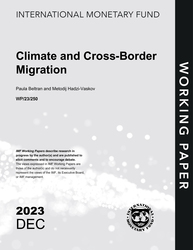
Climate and Cross-Border Migration
Climate and Cross-Border Migration
READ MORE...
Volume/Issue:
Volume 2023
Issue 250
Publication date: December 2023
ISBN: 9798400261879
$20.00
Add to Cart by clicking price of the language and format you'd like to purchase
Available Languages and Formats
| English |
Prices in red indicate formats that are not yet available but are forthcoming.
Topics covered in this book
This title contains information about the following subjects.
Click on a subject if you would like to see other titles with the same subjects.
Economics- Macroeconomics , Economics / General , Environmental Economics , Natural Disasters , Demography , Emigration and Immigration , International Migration , Climate , Climate Disasters , climate disaster , migration outflow , origin-country migration shock , migration pattern , climate-driven migration , Migration , Natural disasters , Climate change , Global
Also of interest
Summary
Our work is positioned at the intersection of migration and climate change—two key forces shaping the economic outlook of many countries. The analysis explores: (i) the relative importance of origincountry vs destination-country factors in explaining migration patterns; (ii) importance of climate disasters as driver of cross-border migration; and (iii) the importance of climate-driven migration on the overall impact of climate on macroeconomic outcomes. It arrives at the following main findings. First, both origin-country and destination-country contribute to explaining migration outflows from EMDEs, although only the global shocks seem important for advanced economies. Second, climate disasters are important for explaining the origincountry migration shocks in LICs and EMDEs, are especially relevant for smaller countries, and lead to migration of both genders, albeit relatively more for males out of LICs. Third, important portion of climate’s overall impact on economic outcomes—especially agricultural GDP, remittances, and inequality—is captured via climate-driven migration. Finally, higher investment in climate-resilient infrastructure can reduce the impact of climate on cross-border migration, and thereby, result in potentially important economic gains.
Copyright © 2010 - 2026
Powered by:
AIDC



